Animals3
Download as ppt, pdf0 likes236 views
This document contains a list of different animal names including: cat, dog, squirrel, lizard, rhino, owl, chipmunk, chicken, rooster, goat, otter, deer, wolf, raccoon, and skunk.
1 of 16
Download to read offline
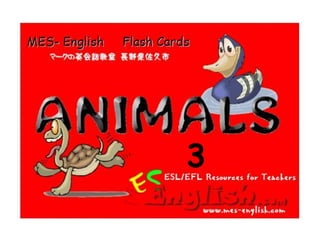
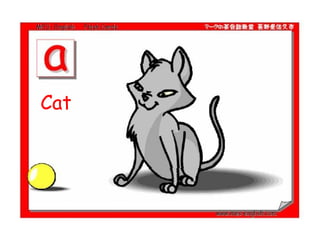
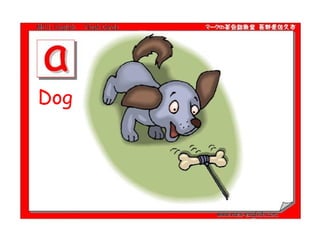


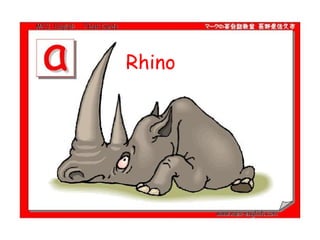
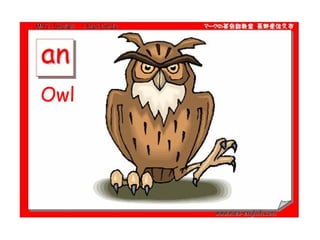
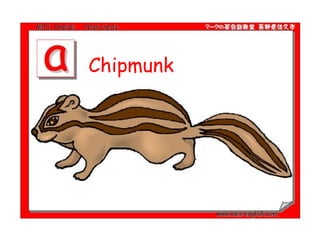
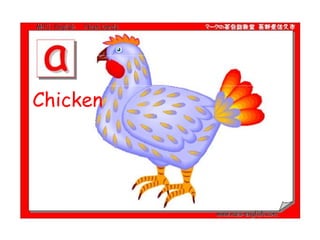
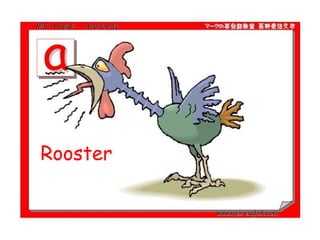
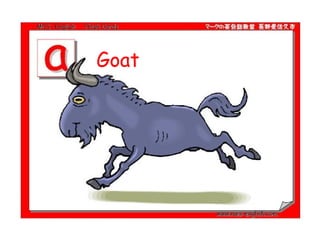
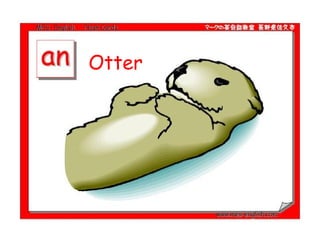
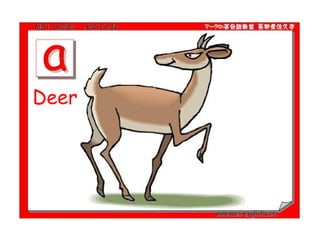

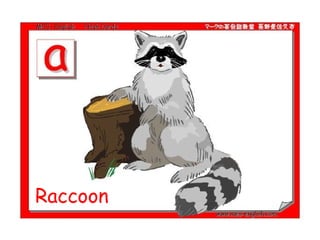

Ad
Recommended
Animals3
Animals3Hasan Ege
╠²
This document contains a list of different animal names including: cat, dog, squirrel, lizard, rhino, owl, chipmunk, chicken, rooster, goat, otter, deer, wolf, raccoon, and skunk.Animals in english 1 (Aula de Inglês)
Animals in english 1 (Aula de Inglês)Adilson P Motta Motta
╠²
This document contains a list of different animal names, including bear, camel, cow, fish, turtle, elephant, gorilla, hippo, horse, lion, panda, rabbit, penguin, duck and frog.Animals in english 2 (Aula de Inglês)
Animals in english 2 (Aula de Inglês)Adilson P Motta Motta
╠²
This document lists various animal species including fox, dolphin, seal, koala, whale, giraffe, monkey, shark, pig, mouse, zebra, snake, donkey, sheep, and kangaroo without any additional context or information provided about the animals.Farm animal and pets vocabulary
Farm animal and pets vocabularyGesang Il
╠²
This document lists common farm animals such as pigs, cows, chickens, goats, sheep, horses, and donkeys. It also lists common pets like dogs, cats, birds, fish, hamsters, reptiles such as chameleons and snakes, and other small animals like hedgehogs, rabbits, turtles, and spiders. The list appears to catalog a variety of livestock and household pets but does not provide any additional context or descriptions.Animals Vocabulary
Animals Vocabularyguest9f40d31
╠²
This document lists various farm, zoo and pet animals. It includes farm animals such as hens, chicks, pigs, horses and cows. Zoo animals mentioned are lions, elephants, giraffes, zebras and tigers. Common pets listed are dogs, cats, fish, mice, birds, rabbits and turtles.C:\Fakepath\Animals
C:\Fakepath\Animalsroooseee
╠²
This document lists common farm animals and instructs the reader to listen to sounds and try to guess the animals. It mentions farm animals such as dogs, pigs, cats, mice, chickens, ducks, sheep, goats, cows, and horses.Full presentation animals
Full presentation animalsaarm31
╠²
This document lists various animal names, including bear, camel, cow, fish, turtle, hippo, horse, lion, panda, penguin, duck, frog, seal, whale, shark, snake, donkey, kangaroo, squirrel, lizard, owl, chicken, rooster, goat, and wolf.The animals
The animalsmelero251
╠²
This document lists various animals including sheep, duck, rabbit, dog, cow, donkey, mouse, pig, cat, parrot, turtle, horse, monkey and elephant.Farm animals
Farm animalscarmenguido3
╠²
This document lists common farm animals in a single word per line format including cow, donkey, duck, hen, horse, ox, pig, rooster, and turkey.Fantastic mr Fox
Fantastic mr Foxagt68
╠²
Mr. Fox and his family steal food like turkey, ham, and other meats from three mean farmers despite the farmers' efforts to stop them. The story involves the characters Mr. Fox, Badger, Weasel, and Mole as they take poultry, veal, and other foods from the farmers by various cooking methods such as boiling, frying, smoking, and stewing.Fantastic mr
Fantastic mragt68
╠²
Mr. Fox and his animal friends steal food like turkey, vegetables, and ham from three mean farmers. The animals enjoy cooking and eating the stolen food in different ways such as roasting, boiling, frying, smoking, and stewing. Their heists and feasts involve working together using their paws and other skills to outwit the farmers.Animals
AnimalsAngelica Guevara
╠²
This document lists various animals including monkey, bee, cat, cow, duck, alligator, hippo, kangaroo, newt, owl, fish, lion, and jellyfish. It does not provide any additional context or details about the animals. The document simply lists these 13 different types of animals.10 Curiosities of the animal kingdom
10 Curiosities of the animal kingdomLarissa Lessa
╠²
This document lists 10 animals: chameleon, honeybee, owl, ladybug, firefly, donkey or mule, mountain goats, squirrel, mantis, and clownfish. It provides short descriptions of curiosities for each of these 10 animals from the animal kingdom.Game informatica basica
Game informatica basicaLucero Angelica Gomez Sanchez
╠²
This document lists different animals including turtle, dog, frog, goat, rabbit, cat, pig, chicken, giraffe, tiger, lion and fish with no other context provided. It contains a list of common animals but does not provide any details about them.Bits Starters (animals)
Bits Starters (animals)mlsevillano
╠²
This document lists various animals in no particular order, including common domestic animals like horse, cow, cat, dog; wild animals such as spider, crocodile, tiger; and farm animals like goat, sheep, chicken. It covers a wide range of animals from mammals to reptiles to birds.Guess the Animal 1
Guess the Animal 1Mel Fung
╠²
The document lists a variety of animals including butterflies, elephants, turtles, and others. It features a mix of mammals, birds, and reptiles. The list highlights biodiversity in the animal kingdom.Domino imprimir ingles
Domino imprimir inglesyesica alexandra mendez gutierrez
╠²
This document lists different animals with two animals per line, though they are not related or in any particular order. It includes a variety of mammals such as rhinos, rabbits, elephants, tigers, bears, zebras, lions, and hippos as well as birds like chickens, ducks and horses and farm animals such as pigs, giraffes and sheep.Guess the Animal 2
Guess the Animal 2Mel Fung
╠²
The document appears to list various animals, including mammals, reptiles, and invertebrates. It features a diverse range of species from different habitats. The list includes commonly known animals such as the giraffe, octopus, and kangaroo.Animals
AnimalsAngelo Messina
╠²
This document lists various animals including: dog, cat, parrot, elephant, octopus, fish, penguin, gorilla, snake, bear, hippo, camel, flamingo, zebra, monkey, pig, tiger, horse, chicken, mouse, bird, lion, dolphin, giraffe, cow, frog, turkey, rabbit, sheep, and turtle. It is organized into two sections, "Animals" and "Unit 2" and provides a simple list of animal names without further details about each one.Presentaci├│n animals
Presentaci├│n animalsPurita60
╠²
This document lists various animals including cat, donkey, hen, goat, giraffe, monkey, mouse, rabbit, tiger, zebra, chick, and dog.Animales
Animalesbilingualbaza
╠²
This document lists different animals with some listed as domestic and others as wild. It includes common farm, pets, and wild animals such as cows, pigs, cats, dogs, sheep, rabbits, squirrels, wolves, foxes, bears, giraffes, horses, and lions with domestic and wild classifications.Herbivores,carnivores and omnivores
Herbivores,carnivores and omnivoresCRISTINA ÁLVAREZ
╠²
This document categorizes common animals as herbivores, carnivores, or omnivores. Herbivores include zebra, rabbit, cow, elephant and giraffe. Carnivores are lion, tiger, crocodile, chameleon and snake. Omnivores that eat both plants and other animals are hen, bear, and pig.Millionaire 5├©
Millionaire 5├©Anna Serrami├Ā
╠²
The document displays the prize amounts for different levels of a game show called "Who Wants To Be A Millionaire". There are 15 levels ranging from $1 Million down to $100. As contestants answer more questions correctly they reach higher levels and larger potential prize amounts.Hippo ariadna xenia
Hippo ariadna xeniaPilar Altemir
╠²
The hippo lives in the savannah, is a very big gray and salmon pink animal, and likes to eat aquatic leaves and fruit while swimming.Animals1
Animals1Anna Serrami├Ā
╠²
This document contains a list of different animal names, including bear, camel, cow, fish, turtle, elephant, gorilla, hippo, horse, lion, panda, rabbit, penguin, duck and frog.Halloween jokes!
Halloween jokes!Anna Serrami├Ā
╠²
This document contains a collection of Halloween jokes. It includes puns and play on words related to ghosts, witches, vampires, skeletons and other Halloween creatures. Some jokes ask riddles about their favorite foods or activities, while others are short one-liners or puns playing on words. The jokes are meant to elicit smiles or chuckles around the spooky holiday of Halloween.Halloween jokes!
Halloween jokes!Anna Serrami├Ā
╠²
This document contains a collection of Halloween-themed jokes. Some jokes play on words like "I-Scream" for what ghosts serve for dessert or reference popular Halloween characters like Dracula and skeletons in jokes about their favorite foods or activities. The jokes are short one-liners primarily focused on word play or common Halloween tropes.Panda.ppt esther
Panda.ppt estherPilar Altemir
╠²
The panda lives in the jungles of China, has black and white fur, and spends much of its time eating bamboo, climbing trees, and sleeping seven hours a day. It is a shy animal.More Related Content
What's hot (15)
Farm animals
Farm animalscarmenguido3
╠²
This document lists common farm animals in a single word per line format including cow, donkey, duck, hen, horse, ox, pig, rooster, and turkey.Fantastic mr Fox
Fantastic mr Foxagt68
╠²
Mr. Fox and his family steal food like turkey, ham, and other meats from three mean farmers despite the farmers' efforts to stop them. The story involves the characters Mr. Fox, Badger, Weasel, and Mole as they take poultry, veal, and other foods from the farmers by various cooking methods such as boiling, frying, smoking, and stewing.Fantastic mr
Fantastic mragt68
╠²
Mr. Fox and his animal friends steal food like turkey, vegetables, and ham from three mean farmers. The animals enjoy cooking and eating the stolen food in different ways such as roasting, boiling, frying, smoking, and stewing. Their heists and feasts involve working together using their paws and other skills to outwit the farmers.Animals
AnimalsAngelica Guevara
╠²
This document lists various animals including monkey, bee, cat, cow, duck, alligator, hippo, kangaroo, newt, owl, fish, lion, and jellyfish. It does not provide any additional context or details about the animals. The document simply lists these 13 different types of animals.10 Curiosities of the animal kingdom
10 Curiosities of the animal kingdomLarissa Lessa
╠²
This document lists 10 animals: chameleon, honeybee, owl, ladybug, firefly, donkey or mule, mountain goats, squirrel, mantis, and clownfish. It provides short descriptions of curiosities for each of these 10 animals from the animal kingdom.Game informatica basica
Game informatica basicaLucero Angelica Gomez Sanchez
╠²
This document lists different animals including turtle, dog, frog, goat, rabbit, cat, pig, chicken, giraffe, tiger, lion and fish with no other context provided. It contains a list of common animals but does not provide any details about them.Bits Starters (animals)
Bits Starters (animals)mlsevillano
╠²
This document lists various animals in no particular order, including common domestic animals like horse, cow, cat, dog; wild animals such as spider, crocodile, tiger; and farm animals like goat, sheep, chicken. It covers a wide range of animals from mammals to reptiles to birds.Guess the Animal 1
Guess the Animal 1Mel Fung
╠²
The document lists a variety of animals including butterflies, elephants, turtles, and others. It features a mix of mammals, birds, and reptiles. The list highlights biodiversity in the animal kingdom.Domino imprimir ingles
Domino imprimir inglesyesica alexandra mendez gutierrez
╠²
This document lists different animals with two animals per line, though they are not related or in any particular order. It includes a variety of mammals such as rhinos, rabbits, elephants, tigers, bears, zebras, lions, and hippos as well as birds like chickens, ducks and horses and farm animals such as pigs, giraffes and sheep.Guess the Animal 2
Guess the Animal 2Mel Fung
╠²
The document appears to list various animals, including mammals, reptiles, and invertebrates. It features a diverse range of species from different habitats. The list includes commonly known animals such as the giraffe, octopus, and kangaroo.Animals
AnimalsAngelo Messina
╠²
This document lists various animals including: dog, cat, parrot, elephant, octopus, fish, penguin, gorilla, snake, bear, hippo, camel, flamingo, zebra, monkey, pig, tiger, horse, chicken, mouse, bird, lion, dolphin, giraffe, cow, frog, turkey, rabbit, sheep, and turtle. It is organized into two sections, "Animals" and "Unit 2" and provides a simple list of animal names without further details about each one.Presentaci├│n animals
Presentaci├│n animalsPurita60
╠²
This document lists various animals including cat, donkey, hen, goat, giraffe, monkey, mouse, rabbit, tiger, zebra, chick, and dog.Animales
Animalesbilingualbaza
╠²
This document lists different animals with some listed as domestic and others as wild. It includes common farm, pets, and wild animals such as cows, pigs, cats, dogs, sheep, rabbits, squirrels, wolves, foxes, bears, giraffes, horses, and lions with domestic and wild classifications.Herbivores,carnivores and omnivores
Herbivores,carnivores and omnivoresCRISTINA ÁLVAREZ
╠²
This document categorizes common animals as herbivores, carnivores, or omnivores. Herbivores include zebra, rabbit, cow, elephant and giraffe. Carnivores are lion, tiger, crocodile, chameleon and snake. Omnivores that eat both plants and other animals are hen, bear, and pig.Viewers also liked (9)
Millionaire 5├©
Millionaire 5├©Anna Serrami├Ā
╠²
The document displays the prize amounts for different levels of a game show called "Who Wants To Be A Millionaire". There are 15 levels ranging from $1 Million down to $100. As contestants answer more questions correctly they reach higher levels and larger potential prize amounts.Hippo ariadna xenia
Hippo ariadna xeniaPilar Altemir
╠²
The hippo lives in the savannah, is a very big gray and salmon pink animal, and likes to eat aquatic leaves and fruit while swimming.Animals1
Animals1Anna Serrami├Ā
╠²
This document contains a list of different animal names, including bear, camel, cow, fish, turtle, elephant, gorilla, hippo, horse, lion, panda, rabbit, penguin, duck and frog.Halloween jokes!
Halloween jokes!Anna Serrami├Ā
╠²
This document contains a collection of Halloween jokes. It includes puns and play on words related to ghosts, witches, vampires, skeletons and other Halloween creatures. Some jokes ask riddles about their favorite foods or activities, while others are short one-liners or puns playing on words. The jokes are meant to elicit smiles or chuckles around the spooky holiday of Halloween.Halloween jokes!
Halloween jokes!Anna Serrami├Ā
╠²
This document contains a collection of Halloween-themed jokes. Some jokes play on words like "I-Scream" for what ghosts serve for dessert or reference popular Halloween characters like Dracula and skeletons in jokes about their favorite foods or activities. The jokes are short one-liners primarily focused on word play or common Halloween tropes.Panda.ppt esther
Panda.ppt estherPilar Altemir
╠²
The panda lives in the jungles of China, has black and white fur, and spends much of its time eating bamboo, climbing trees, and sleeping seven hours a day. It is a shy animal.Expressionism presentation
Expressionism presentationAnna Serrami├Ā
╠²
Expressionism was a modernist movement originating in Germany in the early 1900s that focused on depicting subjective emotions and shapes rather than objective reality through distorted use of color and form. Expressionist artists aimed to express inner experiences rather than depict external reality, taking the word from the German "expressionismus" which refers to self-expression or expression of inner experiences. Some famous expressionist artists include Wassily Kandinsky, Franz Marc, Ernst Ludwig Kirchner, and Emil Nolde.Animals2
Animals2Anna Serrami├Ā
╠²
This document lists various animal species including fox, dolphin, seal, koala, whale, giraffe, monkey, shark, pig, mouse, zebra, snake, donkey, sheep, and kangaroo.Ad